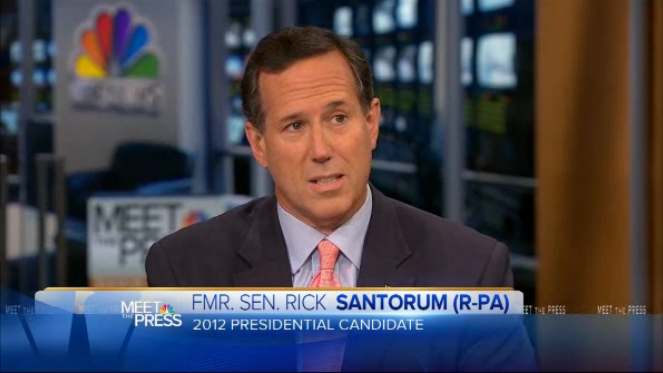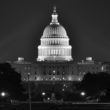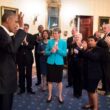Rick Santorum | Source: NBC News)
This week marked the 15th anniversary of the attacks on the U.S. embassies in Kenya and Tanzania, and in a sobering reminder that al Qaeda still poses a serious threat to western interests abroad, the State Department temporarily closed 19 embassies across the Middle East and Africa. Some critics of the Obama Administration, like former Sen. Rick Santorum and former Homeland Security chief Michael Chertoff, have asserted that al Qaeda is stronger than it was a decade and a half ago, and that President Obama has essentially allowed the threat to metastasize because of his timid anti-terror policies.
But while there is no question al Qaeda is resilient and determined, the evidence suggests that the organization is significantly weaker today than it was a few years ago, and the focus on the terror organization has grown demonstrably more aggressive under Obama, who has waged a ruthless drone campaign that has killed more than 30 suspected al Qaeda associates in Yemen in the last week or two alone.
| Critics of the Obama Administration, like former Sen. Rick Santorum and former Homeland Security chief Michael Chertoff, said al Qaeda is stronger than it was a decade and a half ago. While al Qaeda is clearly still a threat, Santorum and Chertoff are clearly wrong. |
The central core of al Qaeda’s leadership and its capacity to successfully execute grand-scale, 9/11-type operations appear to have been very substantially diminished. The organization has splintered into different affiliates groups, the most active one being al Qaeda in the Arabian Peninsula, or AQAP, the group led by Nasir al Wuhayshi, the ambitious leader who escaped from prison in 2006 and has been rebuilding al Qaeda’s presence in Yemen since. AQAP was behind the infamous 2009 Christmas Day bomb plot, and an attempt to blow up cargo planes over U.S. cities in 2010, among others.
The decision to evacuate the embassies was, according to reports, in response to an intercepted conference call between Ayman al-Zawahiri, who succeeded Osama bin Laden as the leader of al Qaeda, and nearly two dozen other prominent terror figures, including Wuhayshi, who is second in command. This type of call would be wildly out of character for Zawahiri, who has evaded capture for years and years by remaining extremely isolated and communicating through personal courier rather than by phone or email. The idea that more than 20 top al Qaeda villains would suddenly be sloppy enough to be on the same call boggles the mind.
But if this is true, it appears the planned attacks involved local targets, which suggests they still don’t have the ability at the moment to wage a large-scale attack within U.S. borders. Since 9/11 there have been several attempts, but most have either been preemptively foiled, or they’ve completely fizzled out. What was once a highly disciplined and extraordinarily effective terrorist group capable of orchestrating the type of carnage we saw on 9/11 seems to have devolved into a group of bumbling affiliates and wannabes. For now. This is a very innovative and dedicated organization that will learn from its past mistakes—shoe bomber, underwear bomber, Times Square bomber—and eventually they’ll find success again in the U.S.
But overseas al Qaeda still poses a very real threat, and the fact that AQAP is bold enough to try and capture entire cities in the region is an ominous sign that they have bigger plans.
One of Obama’s recurring claims on the campaign trail last year was that al Qaeda had been decimated, and was desperately scrambling to survive after bin Laden was killed. This was clearly an overstatement. But it also seems inaccurate to portray it, as Santorum and Chertoff do, as an organization that’s stronger than it was on 9/11. The splintering of al Qaeda has made it weaker, but also more difficult to isolate. This is the reality of a post-cold war world in which our enemies aren’t nice, neat nation-states, but are individuals and shadowy militant groups that can operate from virtually anywhere and coordinate and even receive training over the Internet.
And with hundreds of militants breaking out of prisons in the Middle East recently, it’s entirely possible AQAP and other affiliates are growing their ranks with these escaped prisoners, along with those who may have once been sympathetic to the west, but now have been radicalized in part because of American drone strikes.
Ultimately, the question probably shouldn’t even be whether al Qaeda is stronger or weaker than it once was. Terrorism is a moving target, and as technology advances and a new generation of extremists takes the reins, their methods will evolve. The questions the U.S. needs to ask are how are groups like al Qaeda adapting and innovating? How is the threat different today than it was 12 or 15 years ago? And, most importantly, are our policies, particularly the drone policies that routinely kill civilians, creating terrorists faster than we can kill them?
Doug Daniels is a former staff reporter for Campaigns & Elections. He is the author of the forthcoming memoir Sifting Through the Wreckage.







0 Comments